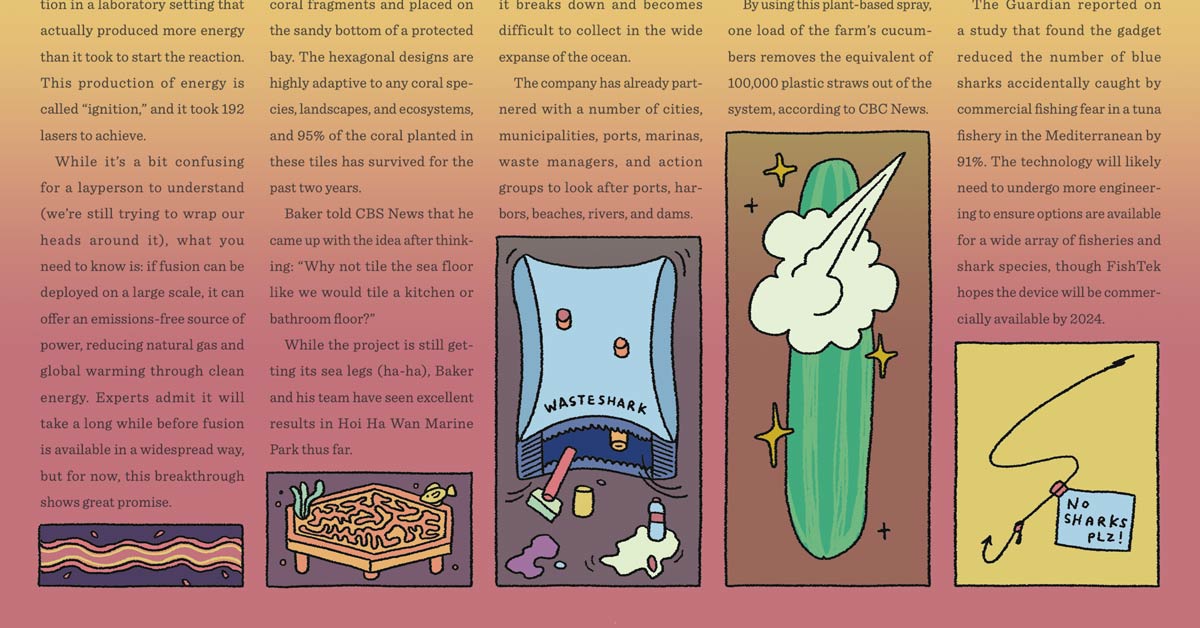While longtime Indigenous practices, good ole community organizing, and personal and political commitments to our planet are constantly at work fighting climate change, new technologies are also rapidly emerging.
Whether we look to global clean energy experts or small, local logistics managers, helpers of all kinds have their hands in healing the earth, one idea at a time.
There are truly too many brilliant solutions to count, but here are five exciting climate breakthroughs that give us hope to keep up the fight.
Hope-Inducing Environmental Breakthroughs To Celebrate
1. Nuclear Fusion
In late 2022, scientists studying fusion energy at Lawrence Livermore National Laboratory in California announced a major breakthrough.
The goal of fusion energy is to reproduce the power of the sun in a laboratory (sounds like a supervillain movie at first, we know!), and these scientists proudly shared that they had their first fusion reaction in a laboratory setting that actually produced more energy than it took to start the reaction. This production of energy is called “ignition,” and it took 192 lasers to achieve.
While it’s a bit confusing for a layperson to understand (we’re still trying to wrap our heads around it), what you need to know is: if fusion can be deployed on a large scale, it can offer an emissions-free source of power, reducing natural gas and global warming through clean energy.
Experts admit it will take a long while before fusion is available in a widespread way, but for now, this breakthrough shows great promise.
2. 3D-Printed Coral Reef Restoration
Archireef, a Hong Kong startup by coral ecologist David Baker, has created the world’s first 3D-printed artificial reef tiles to help rebuild the world’s reefs. The tiles, which were invented with Baker at Hong Kong University, are made from non-toxic, pH-balanced, and biodegradable terracotta.
They’re printed using biomimicry patterns that secure coral fragments and placed on the sandy bottom of a protected bay.The hexagonal designs are highly adaptive to any coral species, landscapes, and ecosystems, and 95% of the coral planted in these tiles has survived for the past two years.
Baker told CBS News that he came up with the idea after thinking: “Why not tile the sea floor like we would tile a kitchen or bathroom floor?”
While the project is still getting its sea legs (ha-ha), Baker and his team have seen excellent results in Hoi Ha Wan Marine Park thus far.
3. Waste-Eating Water Drones
Created by Dutch company RanMarine, meet the WasteSharks. These aquatic drones capture waste in waterways before they get to the ocean, holding up to 160 liters of trash (a little over 350 pounds). Inspired by the whale shark, which catches prey while swimming with a wide-open mouth, these drones gather trash close to the shore before it breaks down and becomes difficult to collect in the wide expanse of the ocean.
The company has already partnered with a number of cities, municipalities, ports, marinas, waste managers, and action groups to look after ports, harbors, beaches, rivers, and dams.
4. Plant-Based Produce Spray
Westmoreland Topline Farms, a cucumber grower in Ontario, Canada was looking for a way to ditch individually plastic-wrapped produce. Working with Apeel Sciences, experts created an edible and tasteless plant-based spray that extends the natural shelf life of a cucumber and removes the need for plastic packaging.
By using this plant-based spray, one load of the farm’s cucumbers removes the equivalent of 100,000 plastic straws out of the system, according to CBC News.
5. Shark Deterrent Fishing Technology
FishTek, a marine engineering company, has tested a gadget called the SharkGuard, which emits a pulse to repel sharks away from fishing gear. The device is clipped onto the line next to a baited hook and sends out a short pulse every two seconds, overstimulating the shark’s nose and mouth and preventing them from getting caught on the line.
The Guardian reported on a study that found the gadget reduced the number of blue sharks accidentally caught by commercial fishing fear in a tuna fishery in the Mediterranean by 91%. The technology will likely need to undergo more engineering to ensure options are available for a wide array of fisheries and shark species, though FishTek hopes the device will be commercially available by 2024.
A version of this article was originally published in The 2023 Environment Edition of the Goodnewspaper.
Get your own Goodnewspaper by becoming a good news subscriber today.



